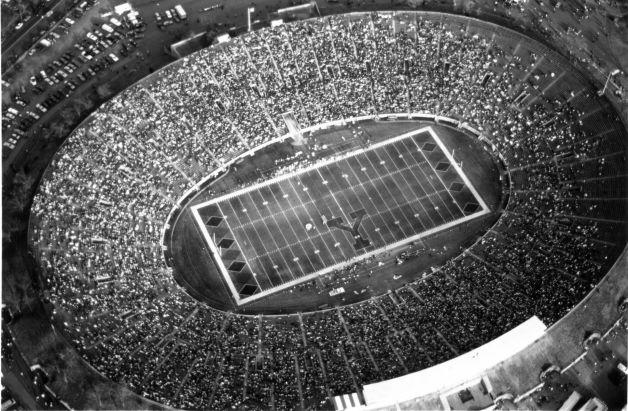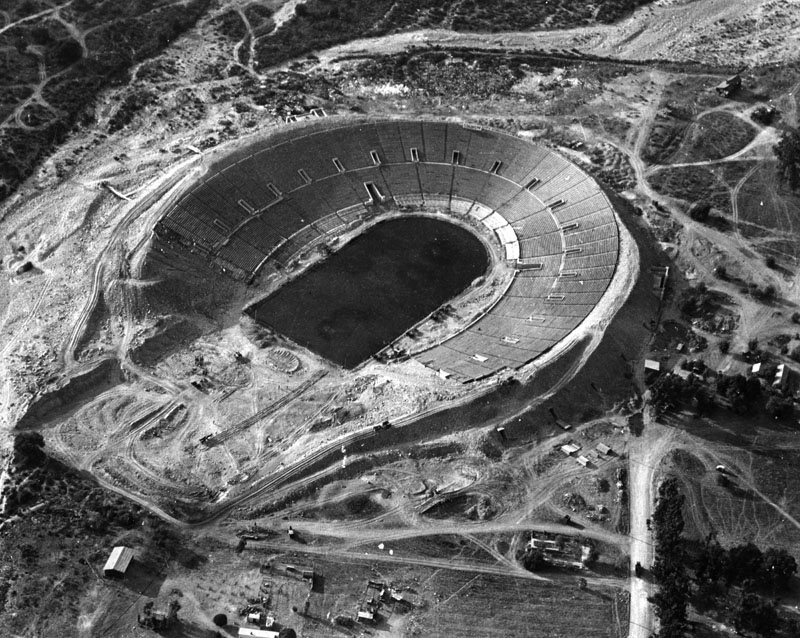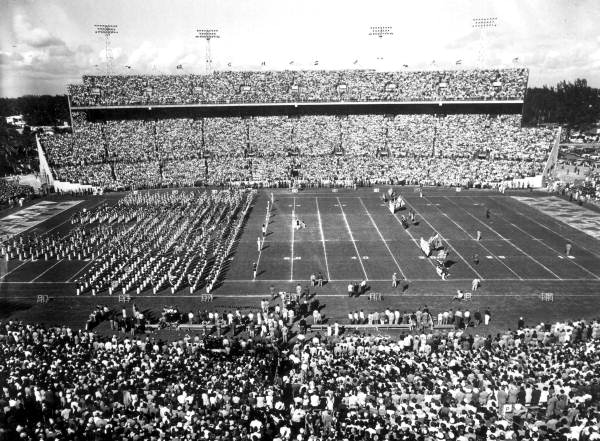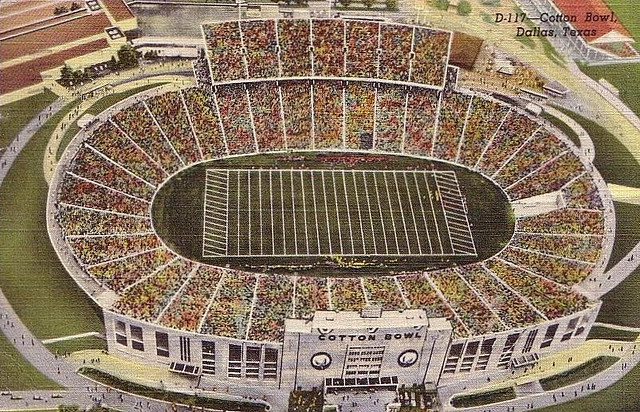There was a time when enormous sporting venues were called bowls, describing their rounded shape, rather than named “Park” or “Stadium” or “Field.” Ignore the 19th century’s Baker Bowl (a diamond-shaped ballpark in Philadelphia) and give full credit to the trailblazing Yale Bowl, opened for play in 1914 with oval dimensions that fit over 70,000 fans, making it the largest sports facility in the nation.
It was designed by Charles Ferry, Yale University class of 1871; its architect was Donn Barber, class of 1893; and it was named by Noah Swayne, Jr., class of 1893.
“I am glad that Yale, in spite of its classical traditions, prefers the good old word ‘bowl,’ ” said Yale president Arthur Twining Hadley in 1912 (quoted by Rich Marazzi in a 100th anniversary article for the New Haven Register), “with its savor of manly English sport, to the ‘coliseum’ of the Romans or the ‘stadium’ of the Greeks.”
The Yale Bowl directly inspired the construction and naming of the Rose Bowl, which opened nine years later in Pasadena, California, with a capacity of 57,000. With a new facility in use, the powers that be changed the name of the Tournament East-West clash (or East-West New Year’s Game) hosted by the city, the very first New Year’s Day postseason college football game. Ever since 1923, football fans have looked forward to the storied Rose Bowl game from the Rose Bowl stadium. The Rose Bowl at the Rose Bowl.
Cause and effect: Because of Yale’s new field in 1914, we now have the Pro Bowl, the Super Bowl, the TaxSlayer Bowl, and the San Diego County Credit Union Poinsettia Bowl today.
The redefining of “Bowl” to describe the game, rather than the field, occurred rapidly.
- The Orange Bowl was the name of a football game decades before it described a facility. First held in Miami as the Festival of Palms Bowl in 1933, the Orange Bowl moved to Burdine Stadium in 1938. Twenty-one years later, Burdine was renamed, allowing the Orange Bowl to be played at the Orange Bowl (as shown above, in 1950). It is now held at Sun Life Stadium.
- Born in 1935, the Sun Bowl is currently played at the Sun Bowl in El Paso, but it was housed at Jones Stadium and then Kidd Stadium before relocating in 1963, twenty-eight years after its inaugural game.
- The Sugar Bowl, dating back to 1935, has never been played at a stadium with that name, moving from Tulane Stadium to the Superdome.
- The Cotton Bowl Classic was played at the Cotton Bowl in Dallas immediately upon its 1937 introduction, though its home was originally named Fair Park Stadium due to its location at the Texas State Fair grounds. It is now played at AT&T Stadium in Arlington, home of the Dallas Cowboys.
A decade later amid World War II, there was no need to associate a Bowl game with a stadium name. Everyone understood what the term “Bowl” meant. Wrote Wilbur D. Jones in “Football! Navy! War!: How Military Lend-lease Players Saved the College Game and Helped Win World War II” (2014), “The armed forces staged at least 27 bowl and all-star games following the 1944 season, 11 within the United States and 16 known games around the world.” The Second Air Force won the 1943 Sun Bowl. Other games included such notable one-offs as the Potato Bowl in Ireland, the Arab Bowl in Algeria, the Parc des Princes Bowl in Paris, the Bambino Bowl in Italy, the Iranian Bowl in Tehran, the Chigger Bowl in Dutch Guiana, the Poi Bowl in Honolulu, the Riviera Bowl in Marseille, the Manila Bowl in the Philippines, the Rice Bowl in China, the Mosquito Bowl in Guadalacanal, and the Atom Bowl in Nagasaki, where, it was reported, the players “had no trouble finding a level surface to use as the playing field [due to] how devastating ‘The Bomb’ actually was.”
Seventy years later, the 2015-2016 college football schedule featured 41 separate bowl games, excluding the national championship itself. (This also excludes the Amos Alonzo Stagg Bowl, determining the Division III national champion.) The slate began on December 19 with the Celebration Bowl in Atlanta and the Cure Bowl in Orlando among six scheduled games, and it ends late into the night on January 2 with the Cactus Bowl in Phoenix.
How many Bowls hosted bowls this season? Five — the 113-year-old Cramton Bowl in Montgomery, Alabama, with the Camellia Bowl; the 79-year-old Orlando Citrus Bowl in Florida; the Sun Bowl; the old faithful Cotton Bowl in Dallas; and the granddaddy of them all, as it is so often said — the Rose Bowl in Pasadena, glorious as ever, home of the New Year’s bowl game tradition, still paying homage to the grand Yale University facility that started everything.




